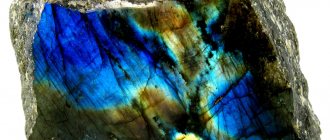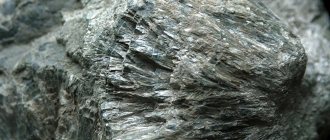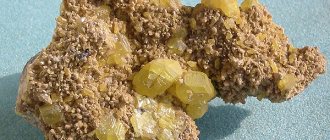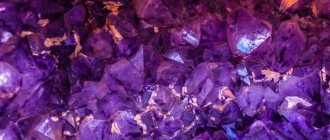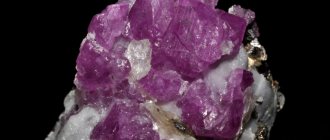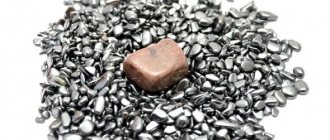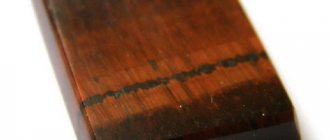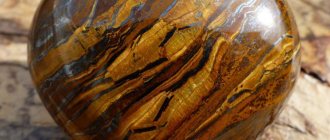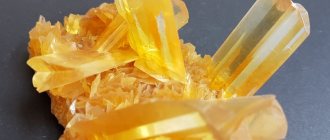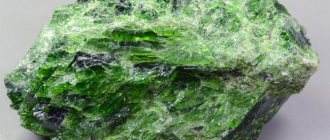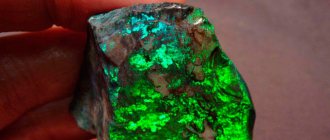Physical properties of basalt
Dark color: black, dark gray. Structure: dense structure, fine-grained. The texture is porous, almond-like or massive. The fracture is uneven. Rough to the touch. Specific gravity 2.6-3.11 g/cm3. Hardness on the Mohs scale from 5 to 7. Melting point 1100 - 1450ºС. The compressive strength of the rock reaches 400 MPa. The most common form of rock occurrence is: flows, covers, domes, dikes. The forms are individually columnar or flagstone.
Features .
Basalt is characterized by a dense, fine-grained structure, uneven fracture, dark (mostly black) color, and high density.
Properties of natural stone
Basalt is a durable and heavy stone with attractive physical properties. It has high strength and good relative elasticity. Also positive is that any temperature changes do not affect it in any way. It is also resistant to both alkalis and acids, and practically does not absorb moisture.
There is another important advantage of basalt - it is resistant to corrosion, it has a complete absence of inductance and field conductivity when exposed to radio frequency energy. And the most important thing is that the material, being the purest product of the earth’s interior, is environmentally friendly.
Origin of basalts
The formation of basalts occurs during the outpouring and solidification of lava of basic composition (SiO2 content 45-52%), both on the surface of continents and in the depths of the oceans. Basalts are the most common igneous rock on the planet, the bulk of which is formed in the oceans, in mid-ocean ridges, forming the base of oceanic tectonic plates (oceanic crust).
Basalts practically do not undergo any secondary processes after formation, being a typical cenotype volcanic rock. During hydrothermal processes, olivine is replaced by serpentine and plagioclase by sericite, the rock becomes chloritized and acquires a greenish tint. Such changes are characteristic mainly of basalts formed at mid-ocean ridges.
As a result of metamorphism, depending on conditions, basalts turn into amphibolites, green and blue shales.
Spreading
Basalts are extrusive igneous rocks with a dense and fine-grained structure found in areas of volcanic eruptions. Young rock can be found in the vicinity of the Kuril and Kamchatka volcanoes. There are amazingly beautiful black and green-black basalts in the areas of Etna and Vesuvius. Nearly black natural rock erupts in Hawaii.
Scientists prize Australian basalts and stones on one of Canada's cliffs. The most ancient basalt monoliths have been preserved on this exotic continent. There is an extremely large amount of this rock in India. Here, the Hindustan tectonic plate, cutting deeply into the Eurasian plate, piled up sedimentary deposits in the form of the Himalayan mountains, thus turning out the lower basalt layers.
Basalt is an amazingly beautiful stone found in nature in a wide variety of shades. Basalts of West African origin have outstanding decorative properties. Moorish varieties are famous for their original colors: beautiful colored splashes on a dark green stone background. Although basalt, compared to other stones, is less frost-resistant, the demand for it is huge. It is quite widely used as a building material.
In China, twilight basalt has a gray tint. It is used both as a finishing material in construction and for paving roads. Siberian and Chinese basalts are considered the most durable and weather-resistant.
Application of basalt
Basalt is used as a construction, facing, acid-resistant material, and also as a raw material for stone casting. The addition of basalt fiber (shavings) increases the impact strength characteristics of concrete products by 5 times.
The rock is used to make a widely used thermal insulation material - stone wool or, as it is also called, basalt fiber. To make basalt wool, basalt crushed stone is returned to the state of liquid lava - melted, and using a simple mechanism, liquid basalt is converted into thin threads, which make up stone wool.
Processing Features
Special machines are used to work with basalt. Industrial plants use cameras. Using processing, you can achieve any effect: from imitation of chips to mirror-like surface. All operations will require diamond blades of different diameters. So, if you need to get a simple, even cut, then use the Ø115×1.6×7.5×22.2 model.
Processing examples:
- Natural chip. The stone is sawn to the required size, then all surfaces are polished except the front. In the case of making a ritual monument, the end is not touched. Then use a chisel to make chips at different angles. The differences can reach 200-300 mm, it all depends on the desire of the master.
- Trimming. The slab is prepared, after which it is cut according to certain parameters. All edges are trimmed so that there are no sharp corners. In production, cutters with diamond attachments are used for this.
- Bucharding. They use a special apparatus - a bush hammer. A polished slab is placed into it, after which the surface is treated with “stars” of different sizes. All this helps to make the basalt “scratched”. Such a surface becomes non-slip and artificially aged - this gives it a special attractiveness.
Take into account the fraction of the instrument. Fine (1500-3000) is suitable for final grinding and polishing, 500-600 is needed for polishing, and coarse for intermediate work. In addition to diamond discs, other tools are used that help make fine parts.
If desired, drawings and inscriptions of any level of complexity can be applied to the basalt. Therefore, it is used to make tombstones. Laser engraving is used for this.
Use in treatment
Combining the elements of fire, air, earth and water, the stone accumulates and retains heat for a long time. Similar properties of basalt have found application in medicine. It has an excellent ability to thermally affect the body.
Since ancient times, basalt has been successfully used in oriental medicine; it is practiced in stone therapy (massage using hot volcanic stones). This technique helps strengthen the body's immune system. Basalts containing olivine are especially good in this regard. Under the influence of the heat of these stones (they heat up to 55 degrees), penetrating deep into the body up to four centimeters, the body relaxes, and this helps relieve stress.
Basalt in stone therapy, which is based on contrasts, plays the role of a hot stone, while marble is cold. This therapy helps rid the body of muscle spasms, kidney pain and osteochondrosis. An important condition of the Eastern method is the use of stones in their natural form. The larger the stone, the more significant its effect on the body.
Hot basalt is also good in combination with natural essential oils, which has a great effect on the relaxation of the body. After each treatment session, it is recommended to clean the stones from the negative energy accumulated in them. They should be washed in clean water or placed in dry salt for a certain time. At the end of such procedures, the basalt should be laid out in a place illuminated by the sun to recharge them with energy.
Field and production
In general, basalts are common among most volcanic rocks. If we consider the territory of Russia, then the mineral is found in Kamchatka, Khabarovsk Territory, Altai and Transbaikalia.
The largest locations are in Ukraine, India, Armenia, and Ethiopia. If we consider more remote areas, the mineral is found in Australia, Italy, South Africa and Greenland.
For the most part, basalt is mined from volcanic lava flows. The upper layers found often have a bubbly surface, this is explained by the fact that during the cooling process, gases and vapors come out of it. Then, locally existing minerals, such as copper, zeolite or calcium, are located in these holes.
Color and color of basalt
The color of the breed is dark. The stone is always black or dark gray. A greenish tint is possible. The dark color comes from volcanic glass. This is what geologists call frozen lava. It has a black color and a glass surface. Plagioclases, or feldspars, are often sulfur, although they come in different shades. Titanomagnetite is dark, bordering on black.
Light basalt does not occur in nature. But such paint is available in the automotive industry. Light basalt is the official color of the Renault Duster model. In total, this crossover is available in 8 shades.
Basalt-based products
Gray basalt is mined in mines and quarries. This is most often done by the mining industry. After removal, it is sent to special enterprises, where various products are made directly from basalt. These can be sandwich panels, tiles, frames for stairs, fibers for insulating roofs and other surfaces. Basalt is also used for the construction of columns, arches, and statues. Its powder is added during the production of reinforced products to ensure their reliability and strength.
Compound
Mineral composition
The bulk is composed of microlites of plagioclase, clinopyroxene, magnetite or titanomagnetite, as well as volcanic glass. Phenocrysts, as already mentioned, are usually represented by olivine, clinopyroxene, plagioclase, and rarely orthopyroxene or hornblende. The most common accessory mineral is apatite.
Chemical composition
The content of silica (SiO2) ranges from 42 to 52-53%, the sum of alkalis Na2+K2 up to 5%, in alkaline basalts up to 7%.
| Oxide | Content, %[4] |
| SiO2 | 47—52 |
| TiO2 | 1—2,5 |
| Al2O3 | 14—18 |
| Fe2O3 | 2—5 |
| FeO | 6—10 |
| MnO | 0,1—0,2 |
| MgO | 5—7 |
| CaO | 6—12 |
| Na2O | 1,5—3 |
| K2O | 0,1—1,5 |
| P2O5 | 0,2—0,5 |
Of greater importance is the classification of basalts based on their chemical composition, which is in certain correspondence with their mineral composition: for example, the SiO2 content increases from melilitites to ordinary basalt. Based on SiO2 content, all basalts are divided into three groups: basic, neutral and acidic. The group of basic basalts includes: olivine melilitite, melilitite, olivine nephelinite, nephelinite, as well as limburgite and augitite, which are characterized by the presence of a glassy phase. According to their chemical composition, this group includes basalt rocks containing up to 42% SiO2. It should be noted that the group of basic basalts should include basalt samples delivered from the Moon. They contain 40-42% SiO2. Sometimes ultrabasic ones (melilitites and olivine nephelinites) with a SiO2 content of less than 40% are distinguished from the group of basic basalts. The neutral group includes basalts with 43-46% SiO2: basanites, leucites and olivine leucites. These basalts contain feldspar. The group of acid basalts includes common basalt, olivine basalt and tephrites (over 46% SiO2).
Secondary changes
As a result of secondary changes, the initially dark gray or black basalts acquire a characteristic greenish color (the so-called greenstone degeneration), and in large masses the characteristic columnar structure appears in the form of 3-7-sided pillars. Mineralogical changes also occur: glass can be replaced by palagonite, an amorphous gel-like substance of greenish or yellowish color, consisting mainly of montmorillonite; Actinolite develops after clinopyroxene; for plagioclase - albite and saussurite. In general, the most common secondary minerals in basalt are calcite, prehnite, and zeolites.
Popular types
Basalt is a general name. It brings together many different types. The most common ones are:
- Asian is an inexpensive stone, widely used in interior design, as well as in architecture. Its color is predominantly that of “wet asphalt”.
- Twilight - large deposits are located in China. It is dark gray, even black. It is considered the highest quality type of medium of all others, since it has a high level of resistance to temperature changes, mechanical damage, humidity fluctuations, etc.
- Moorish - almond-shaped. It has many different inclusions on its surface. The color scheme is mainly green shades. The appearance of such basalt is quite original, which allows it to be used for decorating rooms and buildings. However, it is worth noting that its technical indicators are somewhat inferior: frost resistance and hardness are low.
- Basaltine is the most common type. Large deposits are located near Rome. Refers to the most expensive materials. It has an original surface, which allows it to be widely used in the architectural field. In terms of strength, such basalt can be compared with granite; after laying, it retains all its inherent qualities for a long time.
